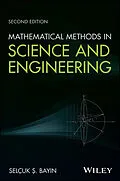A Practical, Interdisciplinary Guide to Advanced Mathematical Methods for Scientists and Engineers
Mathematical Methods in Science and Engineering, Second Edition, provides students and scientists with a detailed mathematical reference for advanced analysis and computational methodologies. Making complex tools accessible, this invaluable resource is designed for both the classroom and the practitioners; the modular format allows flexibility of coverage, while the text itself is formatted to provide essential information without detailed study. Highly practical discussion focuses on the "how-to" aspect of each topic presented, yet provides enough theory to reinforce central processes and mechanisms.
Recent growing interest in interdisciplinary studies has brought scientists together from physics, chemistry, biology, economy, and finance to expand advanced mathematical methods beyond theoretical physics. This book is written with this multi-disciplinary group in mind, emphasizing practical solutions for diverse applications and the development of a new interdisciplinary science.
Revised and expanded for increased utility, this new Second Edition:
* Includes over 60 new sections and subsections more useful to a multidisciplinary audience
* Contains new examples, new figures, new problems, and more fluid arguments
* Presents a detailed discussion on the most frequently encountered special functions in science and engineering
* Provides a systematic treatment of special functions in terms of the Sturm-Liouville theory
* Approaches second-order differential equations of physics and engineering from the factorization perspective
* Includes extensive discussion of coordinate transformations and tensors, complex analysis, fractional calculus, integral transforms, Green's functions, path integrals, and more
Extensively reworked to provide increased utility to a broader audience, this book provides a self-contained three-semester course for curriculum, self-study, or reference. As more scientific disciplines begin to lean more heavily on advanced mathematical analysis, this resource will prove to be an invaluable addition to any bookshelf.
Autorentext
Selçuk . Bayin, PhD, is Professor of Physics at the Institute of Applied Mathematics in the Middle East Technical University in Ankara, Turkey, and a member of the Turkish Physical Society and the American Physical Society. He is the author of Mathematical Methods in Science and Engineering and Essentials of Mathematical Methods of Science and Engineering, also published by Wiley.
Inhalt
Preface xix
1 Legendre Equation and Polynomials 1
1.1 Second-Order Differential Equations of Physics 1
1.2 Legendre Equation 2
1.2.1 Method of Separation of Variables 4
1.2.2 Series Solution of the Legendre Equation 4
1.2.3 Frobenius Method Review 7
1.3 Legendre Polynomials 8
1.3.1 Rodriguez Formula 10
1.3.2 Generating Function 10
1.3.3 Recursion Relations 12
1.3.4 Special Values 12
1.3.5 Special Integrals 13
1.3.6 Orthogonality and Completeness 14
1.3.7 Asymptotic Forms 17
1.4 Associated Legendre Equation and Polynomials 18
1.4.1 Associated Legendre Polynomials Pm l (x) 20
1.4.2 Orthogonality 21
1.4.3 Recursion Relations 22
1.4.4 Integral Representations 24
1.4.5 Associated Legendre Polynomials for m < 0 26
1.5 Spherical Harmonics 27
1.5.1 AdditionTheorem of Spherical Harmonics 30
1.5.2 Real Spherical Harmonics 33
Bibliography 33
Problems 34
2 Laguerre Polynomials 39
2.1 Central Force Problems in Quantum Mechanics 39
2.2 Laguerre Equation and Polynomials 41
2.2.1 Generating Function 42
2.2.2 Rodriguez Formula 43
2.2.3 Orthogonality 44
2.2.4 Recursion Relations 45
2.2.5 Special Values 46
2.3 Associated Laguerre Equation and Polynomials 46
2.3.1 Generating Function 48
2.3.2 Rodriguez Formula and Orthogonality 49
2.3.3 Recursion Relations 49
Bibliography 49
Problems 50
3 Hermite Polynomials 53
3.1 Harmonic Oscillator in QuantumMechanics 53
3.2 Hermite Equation and Polynomials 54
3.2.1 Generating Function 56
3.2.2 Rodriguez Formula 56
3.2.3 Recursion Relations and Orthogonality 57
Bibliography 61
Problems 62
4 Gegenbauer and Chebyshev Polynomials 65
4.1 Wave Equation on a Hypersphere 65
4.2 Gegenbauer Equation and Polynomials 68
4.2.1 Orthogonality and the Generating Function 68
4.2.2 Another Representation of the Solution 69
4.2.3 The Second Solution 70
4.2.4 Connection with the Gegenbauer Polynomials 71
4.2.5 Evaluation of the Normalization Constant 72
4.3 Chebyshev Equation and Polynomials 72
4.3.1 Chebyshev Polynomials of the First Kind 72
4.3.2 Chebyshev and Gegenbauer Polynomials 73
4.3.3 Chebyshev Polynomials of the Second Kind 73
4.3.4 Orthogonality and Generating Function 74
4.3.5 Another Definition 75
Bibliography 76
Problems 76
5 Bessel Functions 81
5.1 Bessel's Equation 83
5.2 Bessel Functions 83
5.2.1 Asymptotic Forms 84
5.3 Modified Bessel Functions 86
5.4 Spherical Bessel Functions 87
5.5 Properties of Bessel Functions 88
5.5.1 Generating Function 88
5.5.2 Integral Definitions 89
5.5.3 Recursion Relations of the Bessel Functions 89
5.5.4 Orthogonality and Roots of Bessel Functions 90
5.5.5 Boundary Conditions for the Bessel Functions 91
5.5.6 Wronskian of Pairs of Solutions 94
5.6 Transformations of Bessel Functions 95
5.6.1 Critical Length of a Rod 96
Bibliography 98
Problems 99
6 Hypergeometric Functions 103
6.1 Hypergeometric Series 103
6.2 Hypergeometric Representations of Special Functions 107
6.3 Confluent Hypergeometric Equation 108
6.4 Pochhammer Symbol and Hypergeometric Functions 109
6.5 Reduction of Parameters 113
Bibliography 115
Problems 115
7 SturmLiouville Theory 119
7.1 Self-Adjoint Differential Operators 119
7.2 SturmLiouville Systems...
